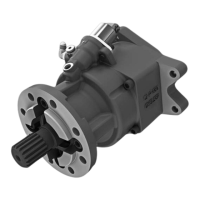Trips and Fault Finding 7-1
590 Series DC Digital Converter
7 TRIPS AND FAULT FINDING
Trips
What Happens when a Trip Occurs
When a trip occurs, the Converter’s power stage is immediately disabled causing the motor and
load to coast to a stop. The trip is latched until action is taken to reset it. This ensures that trips
due to transient conditions are captured and the Converter is disabled, even when the original
cause of the trip is no longer present.
MMI Indications
If a trip condition is detected the unit displays and performs the following actions.
1. The HEALTH LED goes out indicating a Trip condition has occurred. The MMI displays
the activated alarm. (Investigate, find and remove the cause of the trip.)
2. Terminal B6 (Healthy) goes low (0V).
3. The alarm message(s) can be acknowledged by pressing the E key, however, the unit will
not restart at this point. Refer to Chapter 5: “The Man-Machine Interface (MMI)” - Alarm
Message Displays.
Resetting a Trip Condition
All trips must be reset before the Converter can be re-enabled. A trip can only be reset once the
trip condition is no longer active, i.e. a trip due to a heatsink over-temperature will not reset
until the temperature is below the trip level.
Note: More than one trip can be active at any time. For example, it is possible for both the
HEATSINK TRIP and the OVERVOLTS (VA) trips to be active. Alternatively it is possible for
the Converter to trip due to a FIELD OVER I error and then for the HEATSINK TRIP trip to
become active after the Converter has stopped (this may occur due to the thermal time
constant of the heatsink).
You can reset the trip(s) in one of two ways:
1. Power -up, or remove and re-apply the auxiliary power supply.
2. Stop and start the converter, i.e. remove and re-apply the Start/Run signal (terminal C3 or
C4).
Success is indicated by the MMI’s HEALTH LED illuminating. The display will return to its
original display.
Alarm Messages
When a trip occurs an alarm message is displayed on the MMI, and
information about the trip is stored in the ALARM STATUS menu.
The alarm message and the LAST ALARM parameter are displayed
in the selected language of the MMI.
The HEALTH STORE and HEALTH WORD parameters display information as hexadecimal
values, or the sum of the hexadecimal values when more than one alarm is active. Thus the
unique value can represent one or more alarms. For a list of alarms refer to Chapter 6:
“Programming Your Application” - Hexadecimal Representation of Trips.
Note: Hexadecimal refers to the common practice of counting to the base of 16 in computing
rather than the base of 10. The sixteen `numbers’ used being 0 to 9, A to F. Thus an 8
bit byte is represented by two characters in the range 00 to FF, while a 16 bit word is
represented by four characters in the range 0000 to FFFF.
MMI Menu Map
1
ALARM STATUS
LAST ALARM
HEALTH WORD
HEALTH STORE

